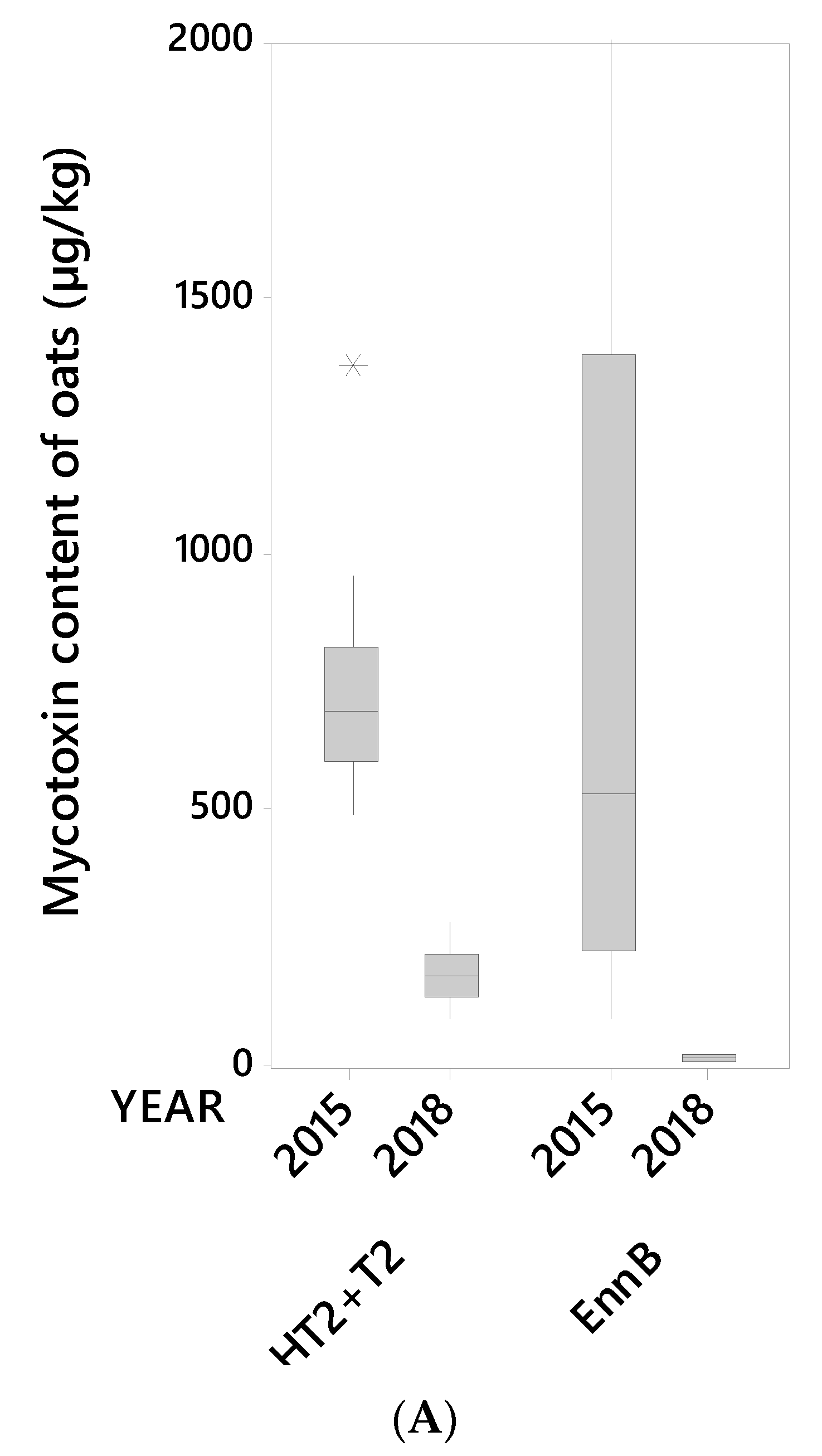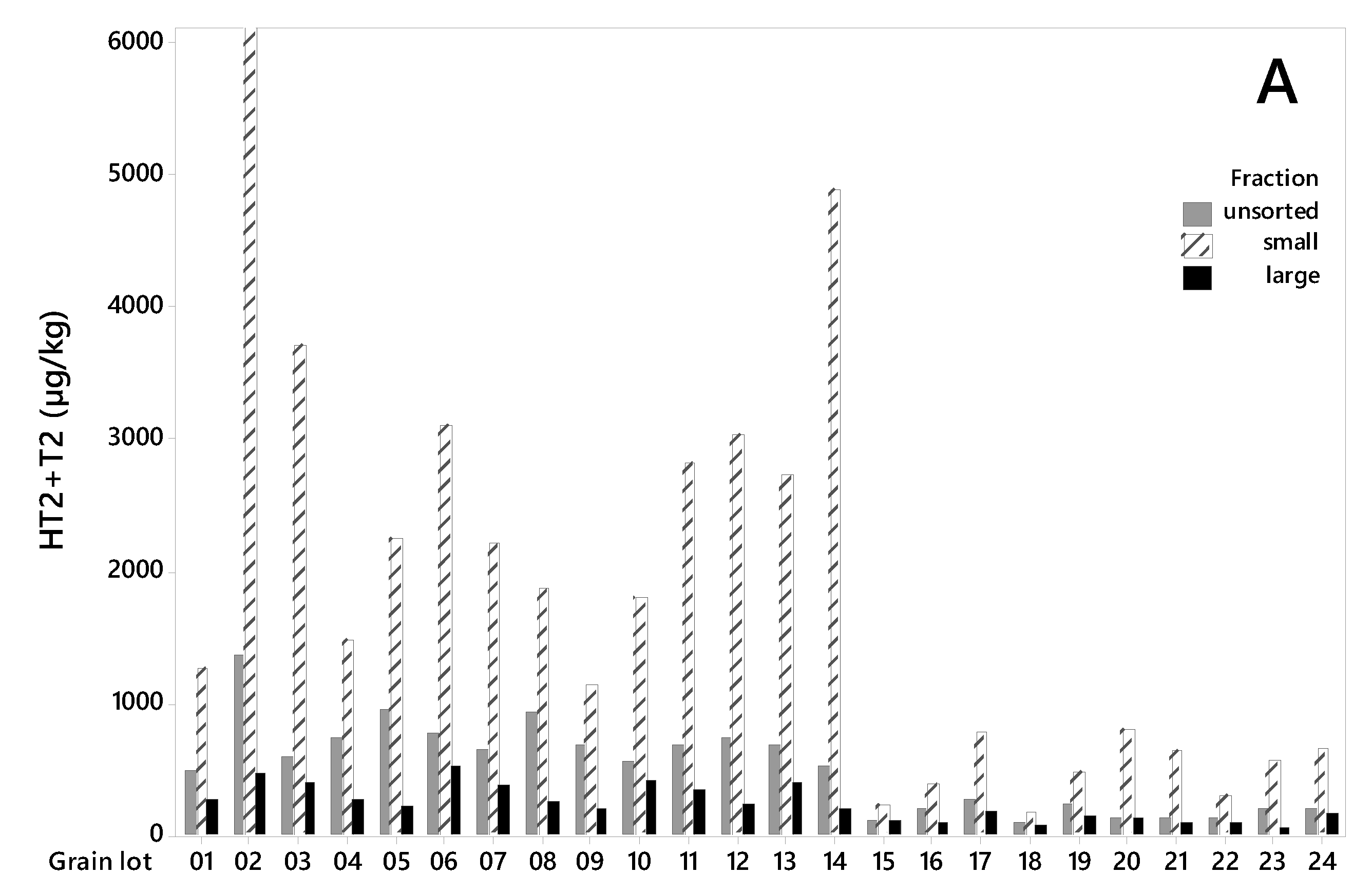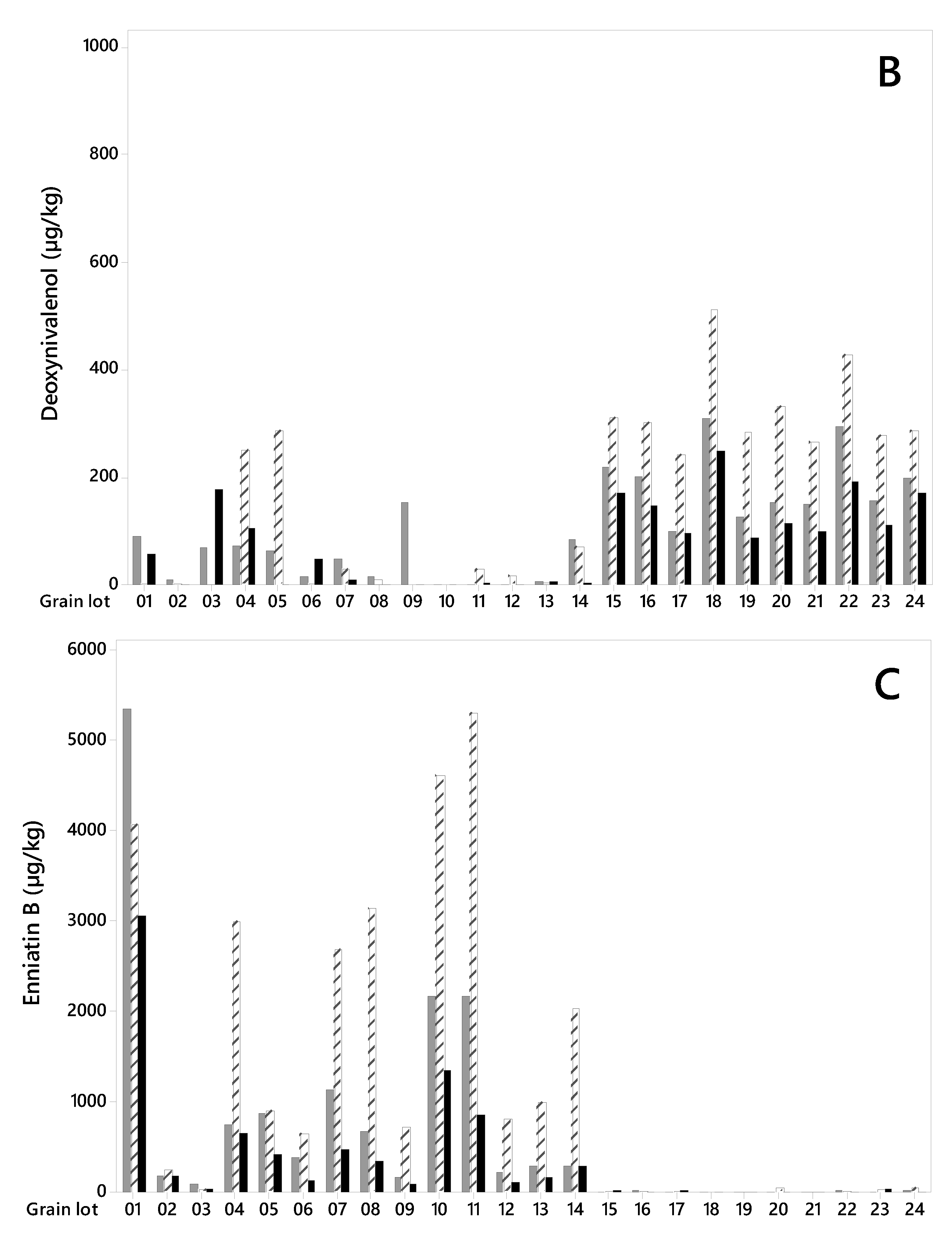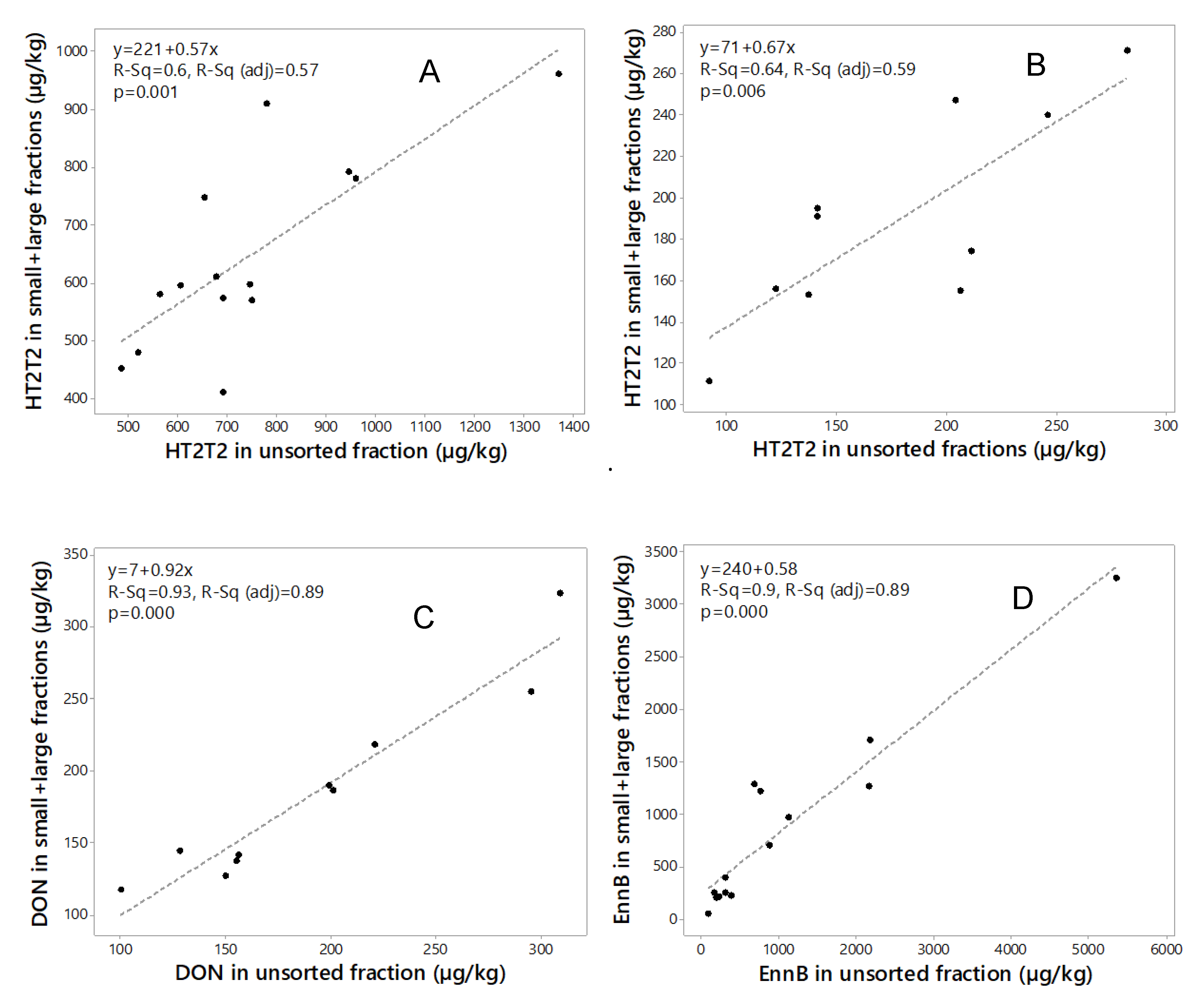Removal of Small Kernels Reduces the Content of Fusarium Mycotoxins in Oat Grain
Abstract
:1. Introduction
2. Results and Discussion
2.1. Mycotoxin Content in the Oat Grain Lots
2.2. Mycotoxin Content in Unsorted and in Large Kernel Fraction of Oats
2.2.1. HT2+T2
2.2.2. DON
2.2.3. Enniatins (Enns) and BEA
2.2.4. NIV, ADON and ZEA
2.3. Mycotoxin Content in the Small Kernel Fraction
2.4. Conditions Influencing on the Effect of Grain Size Sorting
2.5. Grain Weight Reduction by Size Sorting and Mass Balance Calculations
3. Conclusions
4. Materials and Methods
4.1. Oat Grain Materials
4.2. Mycotoxin Analyses
4.3. Data Analyses
Author Contributions
Funding
Acknowledgments
Conflicts of Interest
References
- Desjardins, A.E. Fusarium Mycotoxins: Chemistry, Genetics and Biology; American Phytopathological Society (APS Press): St. Paul, MN, USA, 2006; p. 260. [Google Scholar]
- da Rocha, M.E.B.; Freire, F.C.O.; Maia, F.E.F.; Guedes, M.I.F.; Rondina, D. Mycotoxins and their effects on human and animal health. Food Control 2014, 36, 159–165. [Google Scholar] [CrossRef]
- Pinotti, L.; Ottoboni, M.; Giromini, C.; Dell’Orto, V.; Cheli, F. Mycotoxin Contamination in the EU Feed Supply Chain: A Focus on Cereal Byproducts. Toxins 2016, 8, 45. [Google Scholar] [CrossRef] [PubMed]
- Sundheim, L.; Lillegaard, I.T.; Fæste, C.K.; Brantsæter, A.-L.; Brodal, G.; Eriksen, G.S. Deoxynivalenol Exposure in Norway, Risk Assessments for Different Human Age Groups. Toxins 2017, 9, 46. [Google Scholar] [CrossRef] [PubMed] [Green Version]
- Straumfors, A.; Uhlig, S.; Eriksen, G.S.; Heldal, K.K.; Eduard, W.; Krska, R.; Sulyok, M. Mycotoxins and other fungal metabolites in grain dust from Norwegian grain elevators and compound feedmills. World Mycotoxin J. 2015, 8, 361–373. [Google Scholar] [CrossRef]
- European Commission (EC). Commission Regulation (EC) no. 1881/2006 of 19 December 2006 setting maximum levels for certain contaminants in foodstuffs. Off. J. Eur. Union 2006, L 364, 5–24. [Google Scholar]
- European Commission (EC). Commission Recommendation of 17 August 2006 on the on the presence of deoxynivalenol, zearalenone, ochratoxin A, T-2 and HT-2 and fumonisins in products intended for animal feeding. Off. J. Eur. Union 2006, L 229, 7–9. [Google Scholar]
- Fredlund, E.; Gidlund, A.; Sulyok, M.; Börjesson, T.; Krska, R.; Olsen, M.; Lindblad, M. Deoxynivalenol and other selected Fusarium toxins in Swedish wheat — Occurrence and correlation to specific Fusarium species. Int. J. Food Microbiol. 2013, 167, 284–291. [Google Scholar] [CrossRef]
- Hofgaard, I.S.; Aamot, H.U.; Torp, T.; Jestoi, M.; Lattanzio, V.M.T.; Klemsdal, S.S.; Waalwijk, C.; van der Lee, T.; Brodal, G. Associations between Fusarium species and mycotoxins in oats and spring wheat from farmers’ fields in Norway over a six-year period. World Mycotoxin J. 2016, 9, 365–378. [Google Scholar] [CrossRef]
- Hietaniemi, V.; Rämö, S.; Yli-Mattila, T.; Jestoi, M.; Peltonen, S.; Kartio, M.; Sieviläinen, E.; Koivisto, T.; Parikka, P. Updated survey of Fusarium species and toxins in Finnish cereal grains. Food Addit. Contam. Part A 2016, 33, 831–848. [Google Scholar] [CrossRef]
- Tittlemier, S.A.; Blagden, R.; Chan, J.; Roscoe, M.; Pleskach, K. A multi-year survey of mycotoxins and ergosterol in Canadian oats. Mycotoxin Res. 2020, 36, 103–114. [Google Scholar] [CrossRef]
- Langseth, W.; Rundberget, T. The occurrence of HT-2 toxin and other trichothecenes in Norwegian cereals. Mycopathologia 1999, 147, 157–165. [Google Scholar] [CrossRef] [PubMed]
- Edwards, S.G.; Barrier-Guillot, B.; Clasen, P.-E.; Hietaniemi, V.; Pettersson, H. Emerging issues of HT-2 and T-2 toxins in European cereal production. World Mycotoxin J. 2009, 9, 365–378. [Google Scholar] [CrossRef]
- van der Fels-Klerx, H.; Stratakou, I. T-2 toxin and HT-2 toxin in grain and grain-based commodities in Europe: Occurrence, factors affecting occurrence, co-occurrence and toxicological effects. World Mycotoxin J. 2010, 3, 349–367. [Google Scholar] [CrossRef]
- Schöneberg, T.; Jenny, E.; Wettstein, F.E.; Bucheli, T.D.; Mascher, F.; Bertossa, M.; Musa, T.; Seifert, K.; Gräfenhan, T.; Beat Keller, B.; et al. Occurrence of Fusarium species and mycotoxins in Swiss oats—Impact of cropping factors. Eur. J. Agr. 2018, 92, 123–132. [Google Scholar] [CrossRef]
- Aamot, H.U.; Ward, T.J.; Brodal, G.; Vrålstad, T.; Larsen, G.B.; Klemsdal, S.S.; Eleamen, A.; Uhlig, S.; Hofgaard, I.S. Genetic and phenotypic diversity within the Fusarium graminearum species complex in Norway. Eur. J. Plant Pathol. 2015, 142, 501–519. [Google Scholar] [CrossRef] [Green Version]
- Clemens, R.; van Klinken, B.J.-W. Oats, more than just a whole grain: An introduction. Br. J. Nutr. 2014, 112, S1–S3. [Google Scholar] [CrossRef] [Green Version]
- Ranking of Substances for Monitoring in Foods, Drinks and Dietary Supplements-Based on Risk and Knowledge Gaps. Available online: https://vkm.no/download/18.59c1cc3017057cd177f1653b/1582108692752/Ranking%20of%20substances%20for%20monitoring%20in%20foods,%20drinks%20and%20dietary%20supplements%20-%20based%20on%20risk%20and%20knowledge%20gaps%20revidert2.pdf (accessed on 10 February 2020).
- EFSA (European Food Safety Authority); Arcella, D.; Gergelova, P.; Innocenti, M.L.; Steinkellner, H. Human and animal dietary exposure to T-2 and HT-2 toxin. EFSA J. 2017, 15, 4972. [Google Scholar] [CrossRef]
- European Commission (EC). Commission Recommendation of 27 March 2013 on the presence of T-2 and HT-2 toxin in cereals and cereal products. Off. J. Eur. Union 2013, L 91, 12–15. [Google Scholar]
- Scudamore, K.A.; Baillie, H.; Patel, S.; Edwards, S.G. Occurrence and fate of Fusarium mycotoxins during commercial processing of oats in the UK. Food Addit. Contam. 2007, 24, 1374–1385. [Google Scholar] [CrossRef]
- Schwake-Anduschus, C.; Langenkämper, G.; Unbehend, G.; Dietrich, R.; Märtlbauer, E.; Münzing, K. Occurrence of Fusarium T-2 and HT-2 toxins in oats from cultivar studies in Germany and degradation of toxins during grain cleaning treatment and food processing. Food Addit. Contam. 2010, 27, 1253–1260. [Google Scholar] [CrossRef] [Green Version]
- Yan, W.; Fregeau-Reid, J.; Rioux, S.; Pageau, D.; Xue, A.; Martin, R.; Fedak, G.; de Haan, B.; Lajeunesse, J.; Savard, M. Response of Oat Genotypes to Fusarium Head Blight in Eastern Canada. Crop Sci. 2010, 50, 134–142. [Google Scholar] [CrossRef]
- Pettersson, H.; Brown, C.; Hauk, J.; Meter, J.; Wessels, D. Survey of T-2 and HT-2 toxins by LC-MS/MS in oats and oat products from European oat mills in 2005-2009. Food Addit. Contam. Part B 2011, 4, 110–115. [Google Scholar] [CrossRef] [PubMed]
- Ivanova, L.; Sahlstrøm, S.; Rud, I.; Uhlig, S.; Fæste, C.K.; Eriksen, G.S.; Divon, H.H. Effect of primary processing on the distribution of free and modified Fusarium mycotoxins in naturally contaminated oats. World Mycotoxin J. 2017, 10, 73–88. [Google Scholar] [CrossRef]
- Cheli, F.; Pinotti, L.; Rossi, L.; Dell’Orto, V. Effect of milling procedures on mycotoxin distribution in wheat fractions: A review. LWT Food Sci. Technol. 2013, 54, 307–314. [Google Scholar] [CrossRef]
- Peng, W.-X.; Marchal, J.L.M.; van der Poel, A.F.B. Strategies to prevent and reduce mycotoxins for compound feed manufacturing. Anim. Feed Sci. Technol. 2018, 237, 129–153. [Google Scholar] [CrossRef]
- Schaarschmidt, S.; Fauhl-Hassek, C. The Fate of Mycotoxins during the Processing of Wheat for Human Consumption. Compreh. Rev. Food Sci. Food Saf. 2018, 17, 556–593. [Google Scholar] [CrossRef] [Green Version]
- Edwards, S.G. Fusarium mycotoxin content of UK organic and conventional oats. Food Addit. Contam. 2009, 26, 1063–1069. [Google Scholar] [CrossRef] [Green Version]
- Kaukoranta, T.; Hietaniemi, V.; Rämö, S.; Koivisto, T.; Parikka, P. Contrasting responses of T-2, HT-2 and DON mycotoxins and Fusarium species in oat to climate, weather, tillage and cereal intensity. Eur. J. Plant Pathol. 2019, 155, 93–110. [Google Scholar] [CrossRef] [Green Version]
- Uhlig, S.; Torp, M.; Heier, B.T. Beauvericin and enniatins A, A1, B and B1 in Norwegian grain: A survey. Food Chem. 2006, 94, 193–201. [Google Scholar] [CrossRef]
- Petterson, H.; Börjesson, T.; Persson, L.; Lerenius, C.; Berg, G.; Gustafsson, G. T-2 and HT-2 toxins in oats grown in Northern Europe. Cereal. Res. Commun. 2008, 26 (Suppl. B), 591–592. [Google Scholar]
- Hietaniemi, V.; Rämö, S.; Manninen, P.; Parikka, P.; Hankomäki, J. The effect of cleaning and de-hulling on the trichothecene content inn oats and barley. In Proceedings of the Nordforsk Mould and Mycotoxin Seminar, Uppsala, Sweden, 14–15 April 2009. [Google Scholar]
- Perkowski, J.; Kiecana, I.; Kaczmarek, Z. Natural occurrence and distribution of Fusarium toxins in contaminated barley cultivars. Eur. J. Plant Path. 2003, 109, 331–339. [Google Scholar] [CrossRef]
- Pascale, M.; Haidukowski, M.; Lattanzio, V.M.T.; Silvestri, M.; Ranieri, R.; Visconti, A. Distribution of T-2 and HT-2 Toxins in Milling Fractions of Durum Wheat. J. Food. Prot. 2011, 74, 1700–1707. [Google Scholar] [CrossRef] [PubMed]
- Opoku, N.; Back, M.A.; Edwards, S.G. Susceptibility of cereal species to Fusarium langsethiae under identical field conditions. Eur. J. Plant Pathol. 2018, 150, 869–879. [Google Scholar] [CrossRef]
- Larsen, J.C.; Hunt, J.; Perrin, I.; Ruckenbauer, P. Workshop on trichothecenes with a focus on DON: Summary report. Toxicol. Lett. 2004, 153, 1–22. [Google Scholar] [CrossRef]
- Vaclavikova, M.; Malachova, A.; Veprikova, Z.; Dzuman, Z.; Zachariasova, M.; Hajslova, J. ‘Emerging’ mycotoxins in cereals processing chains: Changes of enniatins during beer and bread making. Food Chem. 2013, 136, 750–757. [Google Scholar] [CrossRef]
- Fraeyman, S.; Croubels, S.; Devreese, M.; Antonissen, G. Emerging Fusarium and Alternaria Mycotoxins: Occurrence, Toxicity and Toxicokinetics. Toxins 2017, 9, 228. [Google Scholar] [CrossRef] [Green Version]
- Maranghi, F.; Tassinari, R.; Narciso, L.; Tait, S.; La Rocca, C.; Di Felice, G.; Butteroni, C.; Corinti, S.; Barletta, B.; Cordelli, E.; et al. In vivo toxicity and genotoxicity of beauvericin and enniatins. Combined approach to study in vivo toxicity and genotoxicity of mycotoxins beauvericin (BEA) and enniatin B (ENNB). EFSA Support. Publ. 2018, 15, EN-1406. [Google Scholar] [CrossRef]
- Jestoi, M.; Rokka, M.; Järvenpää, E.; Peltonen, K. Determination of Fusarium mycotoxins beauvericin and enniatins (A, A1, B, B1) in eggs of laying hens using liquid chromatography–tandem mass spectrometry (LC–MS/MS). Food Chem. 2009, 115, 1120–1127. [Google Scholar] [CrossRef]
- EFSA CONTAM Panel (EFSA Panel on Contaminants in the Food Chain). Scientific Opinion on the risks to human and animal health related to the presence of beauvericin and enniatins in food and feed. EFSA J. 2014, 12, 3802. [Google Scholar] [CrossRef]
- Neuhof, T.; Koch, M.; Rasenko, T.; Nehls, I. Distribution of trichothecenes, zearalenone, and ergosterol in a fractionated wheat harvest lot. J. Agric. Food Chem. 2008, 56, 7566–7571. [Google Scholar] [CrossRef]
- Edwards, S.G.; Dickin, E.T.; MacDonald, S.; Buttler, D.; Hazel, C.M.; Patel, S.; Scudamore, K.A. Distribution of Fusarium mycotoxins in UK wheat mill fractions. Food Addit. Contam. 2011, 28, 1694–1704. [Google Scholar] [CrossRef]
- Schwake-Anduschus, C.; Proske, M.; Sciurba, E.; Muenzing, K.; Koch, M.; Maul, R. Distribution of deoxynivalenol, zearalenone, and their respective modified analogues in milling fractions of naturally contaminated wheat grains. World Mycotoxin J. 2015, 8, 433–443. [Google Scholar] [CrossRef]
- Stuper-Szablewska, K.; Szablewski, T.; Buśko, M.; Perkowski, J. Changes in contents of trichothecenes during commercial grain milling. LWT Food Sci. Technol. 2016, 69, 55–58. [Google Scholar] [CrossRef]
- Edwards, S.G.; Kharbikar, L.L.; Dickin, E.T.; MacDonald, S.; Scudamore, K.A. Impact of pre-harvest rainfall on the distribution of fusarium mycotoxins in wheat mill fractions. Food Control 2018, 89, 150–156. [Google Scholar] [CrossRef]
- Ji, F.; Wu, J.; Zhao, H.; Xu, J.; Shi, J. Relationship of Deoxynivalenol Content in Grain, Chaff, and Straw with Fusarium Head Blight Severity in Wheat Varieties with Various Levels of Resistance. Toxins 2015, 7, 728–742. [Google Scholar] [CrossRef] [Green Version]
- Cheli, F.; Campagnoli, A.; Pinotti, L.; Fusi, E.; Dell’Orto, V. Sampling feed for mycotoxins: Acquiring knowledge from food. It. J. Anim. Sci. 2009, 8, 5–22. [Google Scholar] [CrossRef] [Green Version]
- Tittlemier, S.A.; Blagden, R.; Chan, J.; McMillan, T.L.; Pleskach, K.; Izydorczyk, M.S. Effects of processing whole oats on the analysis and fate of mycotoxins and ergosterol. World Mycotoxin J. 2020, 13, 45–56. [Google Scholar] [CrossRef]
- Klötzel, M.; Lauber, U.; Humpf, H.-U. A new solid phase extraction clean-up method for the determination of 12 type A- and B-trichothecenes in cereals and cereal-based food by LC-MS/MS. Mol. Nutr. Food Res. 2006, 50, 261–269. [Google Scholar] [CrossRef]
- Elbers, I.J.W.; Pereboom, D.P.K.H.; Mol, J.G.J.; Nijs, W.C.M. Proficiency test for mycotoxins in oat meal. Wageningen Food Safety Research. WFSR-Rep. 2019, 51. [Google Scholar] [CrossRef]






| Mycotoxin | Grain Category | 2015 (n = 14) | 2018 (n = 10) | ||||||
|---|---|---|---|---|---|---|---|---|---|
| Mean Toxin Conc. (p-Value) 1 | Min–Max Toxin Conc. | Mean % Change in Toxin Conc. 2 | Range of % Change in Toxin Conc. | Mean Toxin Conc. (p-Value) 1 | Min–Max Toxin Conc. | Mean % Change in Toxin Conc. 2 | Range of % Change in Toxin Conc. | ||
| HT2+T2 | unsorted | 745 | 486–1368 | 178 | 92–282 | ||||
| large | 328 (0.000) | 197–552 | −56 | −24/−76 | 121 (0.001) | 70–187 | −32 | −2/−66 | |
| small | 2775 (0.000) | 1149–6427 | +272 | +66/+840 | 510 (0.005) | 192–804 | +187 | +87/+470 | |
| DON | unsorted | 46 | 1–153 | 191 | 100–309 | ||||
| large | 30 (0.341) | 0–178 | n.a. 3 | n.a. | 145 (0.000) | 89–249 | −24 | −3/−35 | |
| small | 52 (0.811) | 0–290 | n.a. | n.a. | 326 (0.000) | 245–514 | +71 | +42/+145 | |
| ADON | unsorted | 8 | 1–35 | 2.2 | 1–4 | ||||
| large | 5 (0.461) | 0–30 | n.a. | n.a. | 1.6 (0.009) | 1–4 | −27 | n.a. | |
| small | 17 (0.435) | 0–156 | n.a. | n.a. | 4.3 (0.000) | 3–8 | +95 | n.a. | |
| NIV | unsorted | 23 | 0–66 | 6 | 3–9 | ||||
| large | 11 (0.035) | 0–48 | n.a. | n.a. | 6 (n.a.) | 3–7 | n.a. | n.a. | |
| small | 57 (0.164) | 0–295 | n.a. | n.a. | 6 (n.a.) | 4–10 | n.a. | n.a. | |
| EnnA | unsorted | 6 | 1–27 | 1 | 1–2 | ||||
| large | 4 (0.167) | 0–20 | n.a. | n.a. | 1 (n.a.) | 0–2 | n.a. | n.a. | |
| small | 16 (0.095) | 1–91 | n.a. | n.a. | 2 (n.a.) | 1–4 | n.a. | n.a. | |
| EnnA1 | unsorted | 42 | 1–221 | 6 | 3–11 | ||||
| large | 24 (0.064) | 1–151 | n.a. | n.a. | 7 (0.588) | 2–13 | n.a. | n.a. | |
| small | 134 (0.099) | 1–896 | n.a. | n.a. | 12 (0.016) | 4–23 | +120 | −32/+340 | |
| EnnB | unsorted | 1059 | 92–5356 | 15 | 8−25 | ||||
| large | 594 (0.018) | 48–3064 | −44 | +2/−63 | 18 (0.524) | 4−43 | n.a. | n.a. | |
| small | 2101 (0.008) | 37–5319 | +98 | −60/+568 | 33 (0.014) | 12−67 | +120 | −10/+500 | |
| EnnB1 | unsorted | 120 | 6–452 | 18 | 9–38 | ||||
| large | 62 (0.034) | 2–296 | n.a. | n.a. | 19 (0.708) | 5–32 | n.a. | n.a. | |
| small | 229 (0.043) | 2–1001 | n.a. | n.a. | 34 (0.022) | 13–64 | +89 | −15/+337 | |
| BEA | unsorted | 7 | 1–26 | 3 | 1–8 | ||||
| large | 5 (0.083) | 1–22 | n.a. | n.a. | 3 (n.a.) | 1–9 | n.a. | n.a. | |
| small | 10 (0.154) | 1–48 | n.a. | n.a. | 4 (n.a.) | 1–13 | n.a. | n.a. | |
| ZEA | unsorted | 1 | 0–2 | n.d. 4 | |||||
| large | 2 | 1–3 | n.a. | n.a. | n.d. | ||||
| small | 4 | 2–7 | n.a. | n.a. | n.d. | ||||
| Harvest Year | Lot Number | Municipality, Field Number | Cultivar | Weight Proportion (%) | |
|---|---|---|---|---|---|
| Small Kernels | Large Kernels | ||||
| 2015 | 1 | Kongsvinger 1 | Belinda | 18 | 82 |
| 2 | Kongsvinger 2 | Belinda | 8 | 92 | |
| 3 | Belinda | 6 | 94 | ||
| 4 | Kongsvinger 1 | Belinda | 24 | 76 | |
| 5 | Vinger | 27 | 73 | ||
| 6 | Belinda | 15 | 85 | ||
| 7 | Belinda | 22 | 78 | ||
| 8 | Vinger | 33 | 67 | ||
| 9 | Belinda | 22 | 78 | ||
| 10 | Østre Toten | Dovre | 11 | 89 | |
| 11 | GN12142 | 9 | 91 | ||
| 12 | Hamar | Odal | 13 | 87 | |
| 13 | Nord09/127 | 9 | 91 | ||
| 14 | Poseidon | 6 | 94 | ||
| Average weight proportion 1 | 15 | 85 | |||
| 2018 | 15 | Kongsvinger 3 | Ringsaker | 32 | 68 |
| 16 | GN1311 | 25 | 75 | ||
| 17 | Belinda | 14 | 86 | ||
| 18 | Vinger | 28 | 72 | ||
| 19 | Årnes | 28 | 72 | ||
| 20 | Nord13/322 | 9 | 91 | ||
| 21 | Gunhild | 16 | 84 | ||
| 22 | GN14182 | 26 | 74 | ||
| 23 | GN14209 | 17 | 83 | ||
| 24 | GN15154 | 16 | 84 | ||
| Average weight proportion 1 | 21 | 79 | |||
| Mycotoxin (Harvest Year) | Unsorted Grain (Measured) | Weighted Sum of Large and Small Kernel Fractions (Calculated) | % Recovery (Range) |
|---|---|---|---|
| HT2+T2 (2015) | 745 | 648 | 87 (59–120) |
| HT2+T2 (2018) | 178 | 187 | 105 (75–138) |
| DON (2018) | 191 | 184 | 96 (85–117) |
| EnnB (2015) | 1054 | 820 | 77 (51–188) |
| Mycotoxin | Retention Time (min) | Precursor Ion (m/z) | Adduct | Product Ions (m/z) |
|---|---|---|---|---|
| NIV | 3.12 | 371.13476 | [M+CH3COO-] | 281.10284 |
| DON | 3.83 | 355.13984 | [M+CH3COO-] | 295.11835 |
| 3+15-Acetyl-DON | 5.48 | 397.15041 | [M+CH3COO-] | 307.11914 |
| HT-2 | 7.68 | 442.24354 | [M+NH4+] | 363.12781 |
| T-2 | 7.99 | 484.25411 | [M+NH4+] | 305.13818 |
| ZEA | 8.71 | 319.15400 | [M+H+] | 187.07544 |
| Enn B | 9.93 | 657.44331 | [M+H+] | 196.13345 |
| Enn B1 | 10.07 | 671.45896 | [M+H+] | 654.43317 |
| BEA | 10.09 | 801.44331 | [M+H+] | 134.09669 |
| Enn A | 10.16 | 685.47461 | [M+H+] | 210.14906 |
| Enn A1 | 10.28 | 699.49026 | [M+H+] | 228.15967 |
© 2020 by the authors. Licensee MDPI, Basel, Switzerland. This article is an open access article distributed under the terms and conditions of the Creative Commons Attribution (CC BY) license (http://creativecommons.org/licenses/by/4.0/).
Share and Cite
Brodal, G.; Aamot, H.U.; Almvik, M.; Hofgaard, I.S. Removal of Small Kernels Reduces the Content of Fusarium Mycotoxins in Oat Grain. Toxins 2020, 12, 346. https://0-doi-org.brum.beds.ac.uk/10.3390/toxins12050346
Brodal G, Aamot HU, Almvik M, Hofgaard IS. Removal of Small Kernels Reduces the Content of Fusarium Mycotoxins in Oat Grain. Toxins. 2020; 12(5):346. https://0-doi-org.brum.beds.ac.uk/10.3390/toxins12050346
Chicago/Turabian StyleBrodal, Guro, Heidi Udnes Aamot, Marit Almvik, and Ingerd Skow Hofgaard. 2020. "Removal of Small Kernels Reduces the Content of Fusarium Mycotoxins in Oat Grain" Toxins 12, no. 5: 346. https://0-doi-org.brum.beds.ac.uk/10.3390/toxins12050346






